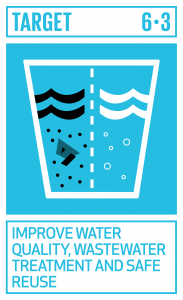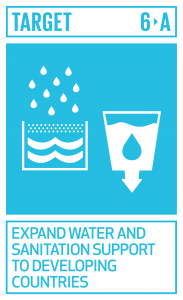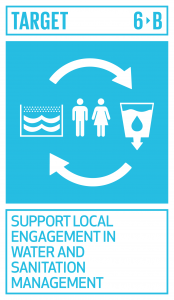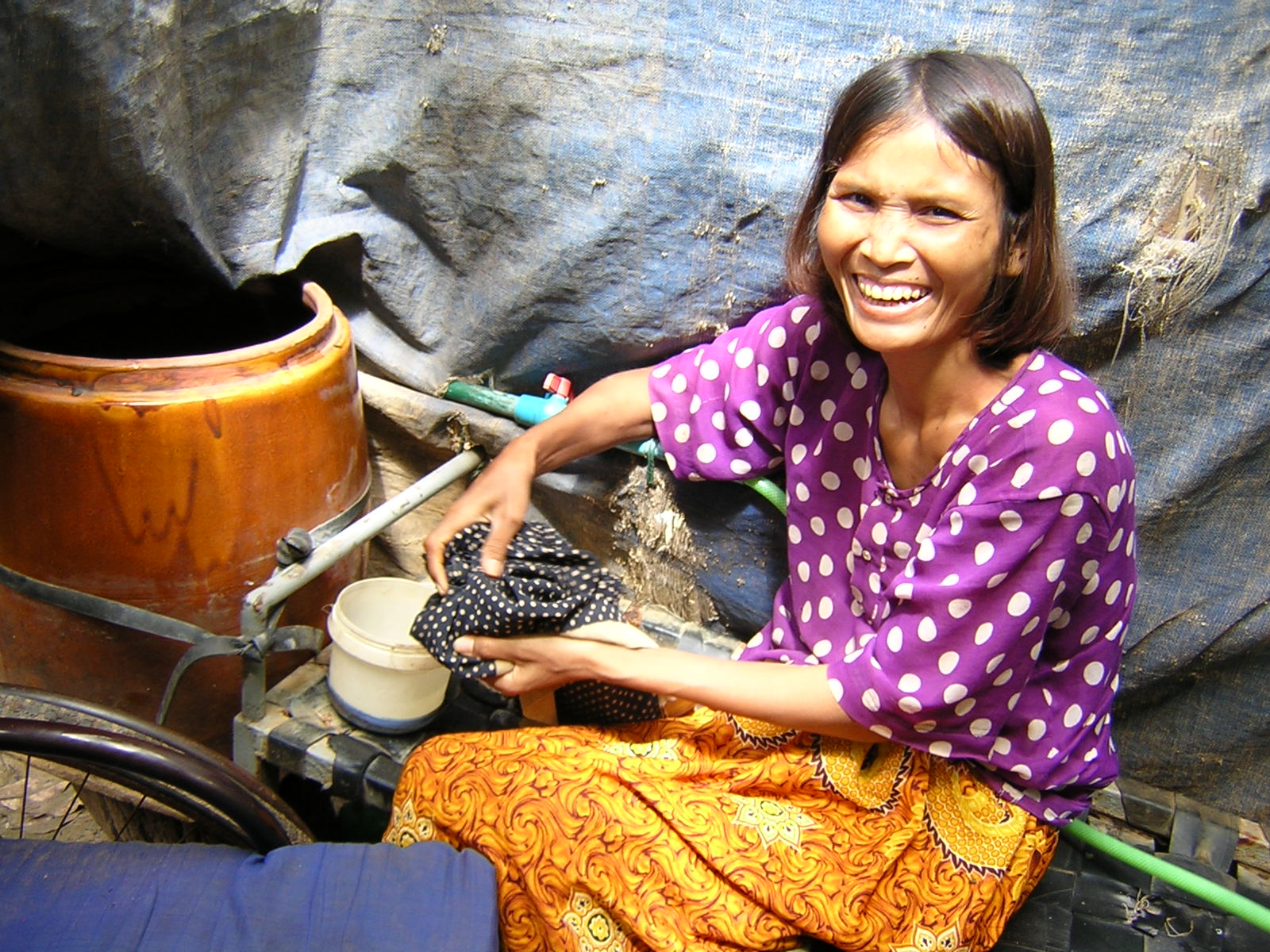Sustainable Development Goal 6 has 8 targets and 11 indicators, which will be used to drive action towards achieving universal access to safely managed water and sanitation and appropriate management of water resources.1 SDG 6 recognizes that sustainably managing water goes beyond providing a safe water supply (target 6.1) and sanitation (target 6.2) as a basic human right. It also focus on issues such as water quality and wastewater management (target 6.3), water scarcity and usage efficiency (target 6.4), water resources management (target 6.5) and the protection and restoration of water-related ecosystems (target 6.6).2
  |   |   |   |
A ‘whole-of-water cycle’ approach is required that includes all users and uses of water and balances these needs equitably. Each SDG 6 target needs to be worked on together to achieve the whole of SDG 6. More than this, safe water and sanitation has been identified as important because if it is not achieved, it makes it more difficult to meet other SDGs.3
Transition from the MDG targets to SDG 6 in Cambodia
Only target 7C of the earlier Millenium Development Goals (MDGs) referred to water and sanitation. It required at least half of the people without sustainable access to safe drinking water and sanitation in 2000 to have access by 2015. This target was measured by two indicators: the proportion of people using (i) an improved drinking water source, and (i) and an improved sanitation facility (toilet).
These targets needed to be changed slightly to make them fit the Cambodian context. Because conditions in rural areas were more challenging than other countries, the indicators were made easier. By 2015, 80% and 50% of people would need to be able to access an improved drinking water source and 74% and 30% would need to be able to access improved sanitation facilities, for urban and rural areas, respectively. 4
The last available publicly available data released by Cambodia is from 2012. It showed that 94% and 66% of people had access to an improved drinking water source and 82% and 25% had access to an improved sanitation facility.5 However, because approximately four-fifths of Cambodians lived in rural areas,6 the water supply indicator had already been met, but the sanitation indicator was unlikely to be reached by 2015.
A new Joint Monitoring Program (JMP) definition has been developed to generate more useful data. The new JMP information also collects data about ‘basic’ hygiene facilities as part of the SDG indicator 6.1.2. A more detailed assessment showed that approximately one-third of Khmer people in rural areas rely on unimproved water sources for everyday use and 60% of people still practiced open defecation.7 Impacts were also different for: people of different genders,8 people with a disability9 and people who live in informal housing in urban areas.10 Children in these situations are especially vulnerable. A 2014 survey in Cambodia found that malnutrition caused in part by poor WASH services means that one in three children are stunted.11
The localization of SDG 6 in Cambodia
A rapid integrated assessment of Cambodia’s National Strategic Development Plan (NSDP) 2014–2018 and other related sector plans was conducted to identify gaps in national policies where each SDG target had limitations in being dealt with by the policy.12
Of the eight SDG 6 targets, two were found to be only partially managed by the National Plan and two others could not be assessed because they were about the means of implementation. It was found that for target 6.2, although there were plans to monitor both rural and urban sanitation indicators, there were only specific plans for improving access in rural areas.13 In the National Strategy for Rural Sanitation and Hygiene, it says that targets 6.1 and 6.2 for rural areas will be met by 2025, which is five years before SDG 6 aims for. However, rural sanitation strategies are not a good fit to urban areas and new policy, technologies and budgets will need to be shared between different ministries to solve these problems in more complex urban areas.
For SDG target 6.4 it was found that the Cambodia Industrial Development Policy (2015–2025)14 only properly deals with water efficiency for the agricultural sector. It does not have a clear plan for managing water efficiency for urban development.15 For target 6.5, transboundary cooperation for the integrated management of water from the Mekong River has not been dealt with.
When the next NSDP is developed for 2019–2022 there will be a good opportunity use SDG 6 as one of the important SDGs that can make it easier to achieve other SDG targets. This includes the SDGs for poverty reduction (SDG 1), gender (SDG 5) and vulnerable groups (SDG 10).16

Bathing bench with plastic strap covering and feed from a rainwater harvesting system to a dedicated tank with pipe and tap in a household in Cambodia. The owner uses a wheelchair and she finds it useful for both bathing and washing clothes. Photo by: WEDC / Sarah House. — Source: Sustainable Sanitation Alliance (SuSanA) Creative Commons Attribution 2.0 Generic license
Means of implementation for SDG 6 in Cambodia
The two means of implementation targets for SDG 6 include:
- How well the government is able to get support from the international community to help resolve the financial and technical limits that stop Cambodia from improving water and sanitation, water efficiency, wastewater treatment, and other ways of reducing water scarcity (target 6.A)
- How easy government policies make it for local people and authorities to participate in water and sanitation management (target 6.B).
The means of assessment goals were not looked at for the rapid assessment, but understanding the priorities and bottlenecks faced in achieving SDG 6 will be important for making partnerships to help develop good policies for the NSDP 2019–2022. For example, the Asian Development Bank studied the water security of different countries in South East Asia and ranked Cambodia the lowest on the Comparative Water Security Index. Cambodia has a score comparable with the other countries for economic water security, but poor results for household and urban water security and water-related disaster resilience.17
The 2017 GLAAS report was clearer about the capacity gaps for Cambodia. It found that the WASH sector did not have a co-ordinated sector-wide approach for financial reporting with the government and many times development partners and NGOs would report about outcomes but not about their expenditure. It was also found that the money spent in urban areas to develop services was paid for by the users in most cases, but for rural areas it was necessary to give microfinance institutions subsidies to make them more willing to provide loans to people to them to build latrines and connect to water piped water.18
Government policies that aim to meet SDG target 6.B and improve public participation in providing WASH services were found to exist in most cases. They do not usually get applied in the same way for all people, however, and are not really useful in encouraging people to be active in rural areas. For urban areas and for the management of water resources, however, these policies have not been developed. Furthermore, with the help of NGOs and development partners, the government has also made plans and budgets to include vulnerable groups and improve their water access and sanitation. However, these are not sufficiently implemented and do not include some vulnerable groups like indigenous people, those with a high disease burden, or those living in urban slums.19
The amount of money Cambodia spends on WASH services is well documented. The government does not have a clear financing plan or budget, however, even though this is important for rural WASH services that still need to be partially subsidised. In 2016, the budget for government spending on WASH services was US$22 million, but only US$4 million dollars was sourced from government revenue. External budgets sources from development partners and NGOs in comparison were much larger (US$176 million). However, despite this level of funding, at this time Cambodia only had enough financing to fund the achievement of less than 50% of urban sanitation indicators for the SDGs, and less than 75% of the budget to meet the indicators for rural sanitation, as well as water supply in both rural and urban areas.20
The figure below shows the World Bank estimates on the cost of providing safely managed water supply (piped to the home) and sanitation (fecal sludge management) for urban and rural areas.21 It shows that the total annual cost for providing rural and urban services is similar, but because it is difficult to provide sanitation to urban areas with many people living closely together, as well as providing piped water access to rural areas where there is a long distance between houses, how the costs are divided up are different. It is also important to understand that only about one-fifth of the Cambodian population lives in urban areas, which means that per capita, the cost of providing WASH services to people in cities is much higher.
Monitoring and evaluation of SDG 6 in Cambodia
The 2017 GLAAS report showed that data is available to support Cambodia to make better decisions to make it easier to attract more financing but it is not sufficiently used to guide decisions about water and sanitation policies in the country.22 The capacity of government officials to do this is being developed through the localization of the SDGs.23 The development of institutional arrangements and information systems is being prioritized before the release of localized goals later in 2018.
This local framework will be supported by three global mechanisms for collecting data to measure CSDG Indicators. These include the JMP for SDG indicators 6.1.1 and 6.1.2 on water, sanitation and hygiene access and the GLAAS report, which has been monitoring means of implementation data since 2010. These two mechanisms will be combined with another through the UN Water Integrated Monitoring Initative (GEMI) to develop approaches for monitoring the remaining SDG indicators.24 Baseline reports for global SDG targets 6.3 to 6.6 will be published in 2018. Draft guidelines for this monitoring framework are available in the meantime,25 which will later be integrated with the Cambodian NSPD 2019–2022.
Related Topics
References
- 1. United Nations Sustainable Development Knowledge Platform 2017. “Sustainable Development Goal 6: Ensure availability and sustainable management of water and sanitation for all”. Accessed March 2018.
- 2. Dahan, S. 2016. “SDG 6 on water and sanitation is essential for sustainable development”. Accessed March 2018.
- 3. UN Water 2016. “Integrated Monitoring Guide for SDG 6: Targets and Global Indicators”. Accessed March 2018.
- 4. Joint Monitoring Program 2014. “Progress on sanitation and drinking-water – 2014 update”. Access March 2018.
- 5. Ibid.
- 6. World Bank 2016. “Kingdom of Cambodia RWSS sector improvement support”. Accessed February, 2018.
- 7. Water and Sanitation Program (WSP) World Bank 2015. “Water and Sanitation in Cambodia: Turning Finance into Services for the Future” Accessed March 2018.
- 8. Pennels, L. 2009. “Why address gender inequality in RWSS improvements”. Accessed March 2018.
- 9. WaterAid 2014. “Accessible WASH in Cambodia” Accessed March 2018.
- 10. Tomassini, M. 2015. “5 Questions: Urban Poor Communities in Cambodia”. Accessed March 2015.
- 11. WaterAid 2017. “How to reach everyone with safe water and sanitation by 2030” Accessed March 2018.
- 12. UNDP 2016 “Rapid Integrated Assessment – Cambodia SDG Profile” Accessed March 2018.
- 13. Ministry of Rural Development 2012. “National Strategy for Rural Sanitation and Hygiene (2011 – 2025)”. Accessed March 2018.
- 14. Royal Government of Cambodia 2015. “Cambodia Industrial Development Policy 2015 – 2025: ‘Market Orientation and Enabling Environment for Industrial Development’’’. Accessed March 2018.
- 15. UNDP 2016. “Rapid Integrated Assessment – Cambodia SDG Scorecard Profile”. Accessed March 2018.
- 16. Grant, M. & J. Willetts 2016. “Gender and SDG 6: The Critical Connection – A Framing Paper for the High Level Panel on Water”. Accessed March 2018.
- 17. Asian Development Bank 2016. “Asian Water Development Outlook 2016: Strengthening Water Security in Asia and the Pacific”. Accessed March 2018.
- 18. Joint Monitoring Program 2017. “Financing Universal Water, Sanitation, and Hygiene under the Sustainable Development Goals: GLAAS 2017 Report”. Accessed March 2018.
- 19. Ibid.
- 20. Ibid.
- 21. Hutton, G. and M. Varughese 2017. “The Costs of Meeting the 2030 Sustainable Development Goal Targets on Drinking Water, Sanitation, and Hygiene” Accessed March 2018.
- 22. Joint Monitoring Program 2017. “Financing Universal Water, Sanitation, and Hygiene under the Sustainable Development Goals: GLAAS 2017 Report”. Accessed March 2018.
- 23. Sovandy, P. 2017. “SDG Localization into Cambodian Context: Progress, M&E Framework and Next Step”. Accessed March 2018.
- 24. UN Water 2016. “GEMI”. Accessed March 2018.
- 25. UN Water 2016. “Integrated Monitoring Guide for SDG 6”. Accessed March 2018.

